淋巴系统LymphaticSystem
淋巴、内分泌

胃左 淋巴 结 胰淋巴结
脾淋巴结
第四节 部分器官的淋巴引流
一、肺的淋巴引流 气管支气 管淋巴结 肺淋巴结 肺门淋巴结 气管支气管淋巴结 气管旁淋巴结
气管旁淋巴结
气管支 气管淋 巴结 肺 淋 巴 结
二、食管的淋巴引流 : 分三段:
1)食管上1/3段的淋巴管
气管旁淋巴结、颈外侧深淋巴结 2)食管中1/3段的淋巴管 气管支气管淋巴结和纵隔后淋巴结 3)食管下1/3段的淋巴管 胃左淋巴结 食管部分淋巴管 胸导管
腹股沟浅淋巴结
腰淋巴结
腹股沟浅淋巴结
闭孔 淋巴 结
骶淋 巴结
闭孔淋巴结
七、乳房的淋巴引流
1)乳房外侧部和中央部的淋巴管 胸肌淋巴结 2)上部的淋巴管 尖淋巴结和锁骨上淋巴结 3)内侧部的淋巴管 胸骨旁淋巴结 4)内侧部的淋巴管与对 侧淋巴管、肝的淋巴管向 交通。 尖淋巴结
第五节 胸腺
位置:胸腺三角内
三、胃的淋巴引流 1.胃底右侧、贲门部和胃小弯侧的淋巴 2.幽门小弯侧的淋巴 幽门上淋巴结 胃左淋巴结
3.胃底左侧、胃大弯左侧淋巴
胃网膜左、胰和脾淋巴结
胃左 淋巴 结 胰淋巴结
4.胃大弯右侧和幽门部淋巴 幽门上
胃网膜右和幽门下淋巴结 胃网膜左
幽门下 脾淋巴结 胃网膜右
四、肝的淋巴引流
膈上淋巴结和肝淋巴结 肝膈面的淋巴管 肝脏面淋巴管 腹腔淋巴结和胃左淋巴结 肝淋巴结、腹腔淋巴结和膈上淋巴结
腺垂体
生长激素 促甲状腺激素 促肾上腺皮质激素 促性腺激素 加压素 催产素
N垂体
巨人症
侏儒症
二、甲状腺thyroid gland ★
一)形态和位置 上端:甲状软骨中部 •侧叶 下端:第6气管软骨环
解剖学之淋巴系统

各部最后一群淋巴结输出管
淋 巴 干
汇集九条淋巴干
左右颈干 左右锁骨下干 左右支气管纵膈干
lymphatic trunks
左右腰干
肠干
淋 胸导管: 注入左静脉角 巴 导 管 右淋巴导管: 注入右静脉角
lymphatic duct
胸导管 最粗大30—40cm长
内脏:位器官门
置 腹盆:位血管周围多与血管同名
功 滤过淋巴
产生淋巴细胞
能
免疫应答产生抗体等
局部淋巴结
regional lymph node
身体局部区域或器官 的淋巴管首先注入的 淋巴结称局部淋巴结
(临床称哨位淋巴结或 一级淋巴结)
2、扁桃体
palatine tonsil
淋巴与上皮组织构成的淋巴 上皮器官。有鄂扁桃体、咽 扁桃体、舌扁桃体等。
thoracic duct
起 始
乳糜池
位置:第1腰椎前方 组成:左右腰干和肠干
膈主动脉裂孔
行
程 胸腔食管后方
第5胸椎高度斜向左侧
颈根部注入左静脉角
收 集 范
左颈干 左锁骨下干 左支气管纵膈干 左右腰干
围 肠干
下半身 左侧上半身 全身3/4区域的淋巴
右淋巴导管
right lymphatic duct
淋巴的产生与回流
淋巴导管
心脏
淋巴干
静
动
脉
淋巴结
淋巴管
脉
毛细淋巴管
组织液
毛细血管
淋巴回流
1 回收蛋白质运输脂肪及营养物质 2 清除组织中的红细胞细菌和异物 3 调节血浆和组织液间的液体平衡 4 产生淋巴细胞和浆细胞参与免疫反应
系统解剖 淋巴系统 英文版Lymphatic System汇总
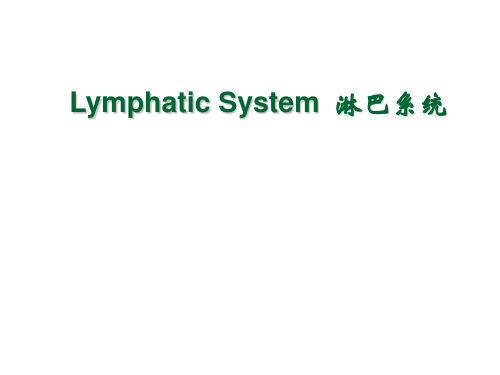
vessels and nerves
Passes through at least one
lymph node and often several
淋巴干Lymphatic trunk
右淋巴导管 ★淋巴干Lymphatic trunk 右颈干 左颈干 左、右颈干jugular trunk 右锁骨下干 左锁骨下干 头颈部 右支气管纵隔干 左、右支气管纵隔干 左支气管纵隔干
Cell
Tissue fluid
120ml/h
Lymphatic vessel
淋巴 lymph
Composition of the Lymphatic System Lymphatic vessels 淋巴管 Lymphatic capillary 毛细淋巴管 Lymphatic vessels 淋巴管 Lymphatic trunks: 淋巴干(九条) Lymphatic ducts: 淋巴导管 thoracic duct 胸导管 right lymphatic duck 右淋巴导管 Lymphatic tissue 淋巴组织 Lymphatic organ 淋巴器官 Lymphatic nodes 淋巴结 Spleen 脾 thymus 胸腺 Tonsil 扁桃体
★
Lymphatic capillary 毛细淋巴管
Begin blindly
The wall is composed of a single
layer of overlapping endothelial cells
They are numerous and form
complex networks
Travels upward, veering to the left
19.淋巴系统
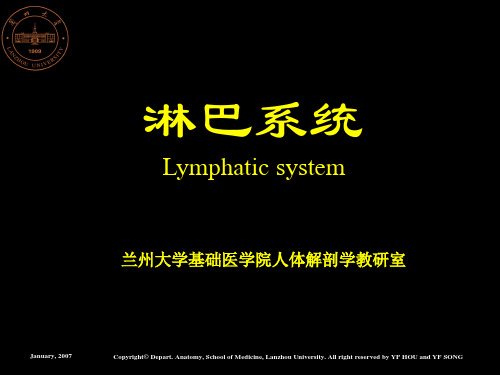
淋巴导管(lymphatic duct)淋巴干合成
两条淋巴导管,即胸导管和右淋巴导right© Depart. Anatomy, School of Medicine, Lanzhou University. All right reserved by YP HOU and YF SONG
孤立淋巴滤泡 集合淋巴滤泡 淋巴小结
January, 2007
Copyright© Depart. Anatomy, School of Medicine, Lanzhou University. All right reserved by YP HOU and YF SONG
(三)淋巴器官
淋巴器官包括:
一、淋巴系统的组成和结构特点
1.淋巴管道 2.淋巴组织 3.淋巴器官
January, 2007
Copyright© Depart. Anatomy, School of Medicine, Lanzhou University. All right reserved by YP HOU and YF SONG
January, 2007
一、 胸导管
胸导管(thoracic duct)是全身最大的
淋巴管。
长度:30--40cm 起止:乳糜池(平T12下缘)--左静脉角 行程:自12胸椎下缘上行,经主动脉裂孔 进胸腔;在脊柱前方行至颈部。 收集范围:两下肢、盆腹部、左胸部、左上 肢、左头颈部,即全身3/4部分的淋巴。
January, 2007 Copyright© Depart. Anatomy, School of Medicine, Lanzhou University. All right reserved by YP HOU and YF SONG
淋巴系统 PPT

专属客服
VIP专属客服,第一时间解决你的问题。专属客服QQ:800049878
路漫部权益:1.海量精选书免费读2.热门好书抢先看3.独家精品资源4.VIP买的VIP时长期间,下载特权不清零。
100W优质文档免费下 载
VIP有效期内的用户可以免费下载VIP免费文档,不消耗下载特权,非会员用户需要消耗下载券/积分获取。
部分付费文档八折起 VIP用户在购买精选付费文档时可享受8折优惠,省上加省;参与折扣的付费文档均会在阅读页标识出折扣价格。
缘、脾门、脾切迹、副脾(20%)。 位置:左季肋部、胃底与膈之间;左9~11
肋深面。 作用:储血、造血、清除衰老红细胞、储
铁、免疫答应。
脾 的 位 置
脾 膈 面 观
脾 脏 面 观
三、胸导管
长度:30--40cm 起止:乳糜池--左静脉角 行程:自12胸椎下缘上行,经主动脉裂
孔进胸腔;在脊柱前方行至颈部。 收集范围:两下肢、盆腹部、左肺、左
0下载券文档一键搜索 VIP用户可在搜索时使用专有高级功能:一键搜索0下载券文档,下载券不够用不再有压力!
内容特 无限次复制特权 权 文档格式转换
知识影响格局,格局决定命运! VIP有效期内可以无限次复制文档内容,不用下载即可获取文档内容
VIP有效期内可以将PDF文档转换成word或买的VIP时长期间,下载特权不清零。
100W优质文档免费下 载
VIP有效期内的用户可以免费下载VIP免费文档,不消耗下载特权,非会员用户需要消耗下载券/积分获取。
部分付费文档八折起 VIP用户在购买精选付费文档时可享受8折优惠,省上加省;参与折扣的付费文档均会在阅读页标识出折扣价格。
服务特 权
共享文档下载特权
20淋巴系统英文单词
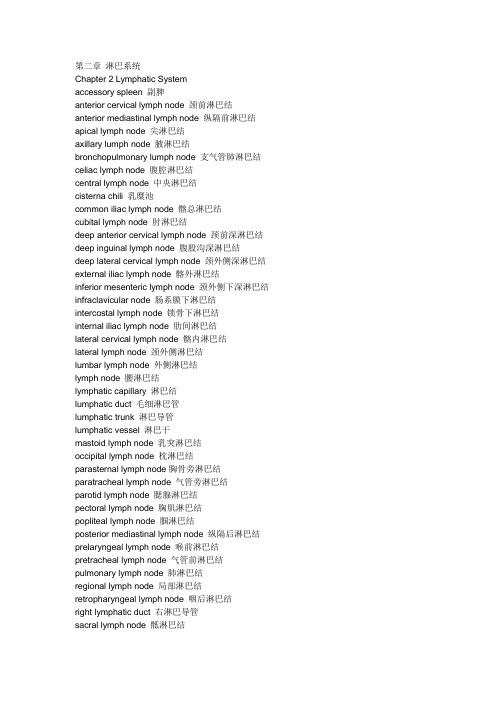
第二章淋巴系统Chapter 2 Lymphatic Systemaccessory spleen 副脾anterior cervical lymph node 颈前淋巴结anterior mediastinal lymph node 纵隔前淋巴结apical lymph node 尖淋巴结axillary lumph node 腋淋巴结bronchopulmonary lumph node 支气管肺淋巴结celiac lymph node 腹腔淋巴结central lymph node 中央淋巴结cisterna chili 乳糜池common iliac lymph node 髂总淋巴结cubital lymph node 肘淋巴结deep anterior cervical lymph node 颈前深淋巴结deep inguinal lymph node 腹股沟深淋巴结deep lateral cervical lymph node 颈外侧深淋巴结external iliac lymph node 髂外淋巴结inferior mesenteric lymph node 颈外侧下深淋巴结infraclavicular node 肠系膜下淋巴结intercostal lymph node 锁骨下淋巴结internal iliac lymph node 肋间淋巴结lateral cervical lymph node 髂内淋巴结lateral lymph node 颈外侧淋巴结lumbar lymph node 外侧淋巴结lymph node 腰淋巴结lymphatic capillary 淋巴结lumphatic duct 毛细淋巴管lumphatic trunk 淋巴导管lumphatic vessel 淋巴干mastoid lymph node 乳突淋巴结occipital lymph node 枕淋巴结parasternal lymph node胸骨旁淋巴结paratracheal lymph node 气管旁淋巴结parotid lymph node 腮腺淋巴结pectoral lymph node 胸肌淋巴结popliteal lymph node 腘淋巴结posterior mediastinal lymph node 纵隔后淋巴结prelaryngeal lymph node 喉前淋巴结pretracheal lymph node 气管前淋巴结pulmonary lymph node 肺淋巴结regional lymph node 局部淋巴结retropharyngeal lymph node 咽后淋巴结right lymphatic duct 右淋巴导管sacral lymph node 骶淋巴结sentinel lymph node 哨位淋巴结spleen 脾splenic hilum 脾门splenic notch 脾切迹submandibular lymph node 下颌下淋巴结submental lymph node 颏下淋巴结subscapular lymph node 肩胛下淋巴结superficial anterior cervical lymph node 颈前浅淋巴结superficial inguinal lymph node 腹股沟浅淋巴结superior deep lateral cervical lymph node 颈外侧浅淋巴结superior deep lateral cervical lymph node 颈外侧上深淋巴结superior mesenteric lymph node 肠系膜上淋巴结superior phrenic lymph node 膈上淋巴结supraclavicular lymph node 锁骨上淋巴结thoracic duct 胸导管thymus 胸腺thyroid lymph node 甲状腺淋巴结tracheobronchial lymph node 气管支气管淋巴结。
人体解剖学-淋巴系统

2.淋巴管Lymphatic vessel
特点:
① 管壁薄,有瓣膜 ② 分浅、深两种 ③ 多个淋巴结穿插其间
3、淋巴干lymphatic trunks
左、右颈干(头颈部) 左、右锁骨下干(上肢) 左、右支气管纵隔干(胸部) 左、右腰干(盆腔下肢) 肠干(腹腔)
4.淋巴导管Lymphatic ducts
左颈干 左锁骨下干 左支气管纵隔干 左、右腰干 肠干 全身3/4区域的淋巴回流
右淋巴导管right Lymphatic ducts
右淋巴导管注入右静 脉角,接受右颈干、右锁 骨下干、右支气管纵隔干 ,全身1/4部位的淋巴。
第三节 淋巴器官
淋巴结 脾 胸腺
淋巴结Lymphatic node
是淋巴管向心行程 中的必经器官。
直径2-20mm,质软。 淋巴结门 浅深淋巴结
淋巴结Lymphatic node
局部淋巴结
引流某一器管或部位淋巴的第一级淋巴结
人体各部的淋 巴管和淋巴结
一、头颈部淋巴结
颏下淋巴结 下颌下淋巴结 腮腺淋巴结
一、头颈部淋巴结
颈前淋巴结 颈外侧浅淋巴结 颈外侧深淋巴结
咽后淋巴结 颈内静脉淋巴结 锁骨上淋巴结
第二节 淋巴管道
1.毛细淋巴管 2 .淋巴管 3 .淋巴干: nine 4 .淋巴导管: thoracic duct right
lymphatic duck
1、毛细淋巴管Lymphatic capillary
特点:
1、以膨大的盲端起于组织间隙; 2、管壁由单层内皮细胞构成,无基膜和周细胞。 管壁通透性大。一些大分子物质如蛋白质、细菌和 癌细胞等较易进入毛细淋巴管。
脾切迹, 是触诊时辩 认脾的标志。
人体解剖英语词汇大全了解人体器官骨骼和生理功能的英文英语词汇
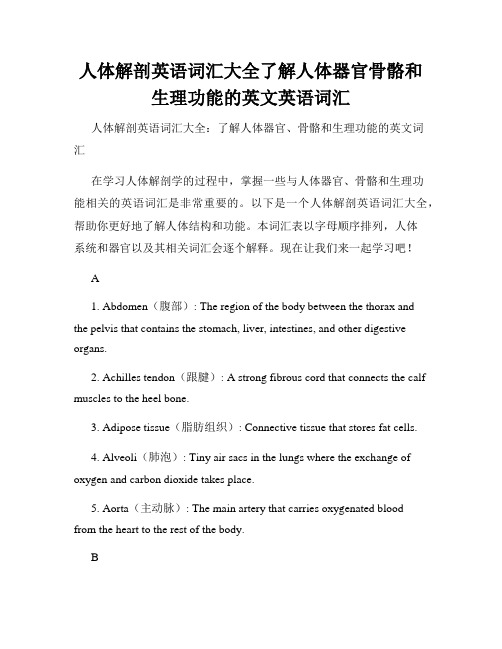
人体解剖英语词汇大全了解人体器官骨骼和生理功能的英文英语词汇人体解剖英语词汇大全:了解人体器官、骨骼和生理功能的英文词汇在学习人体解剖学的过程中,掌握一些与人体器官、骨骼和生理功能相关的英语词汇是非常重要的。
以下是一个人体解剖英语词汇大全,帮助你更好地了解人体结构和功能。
本词汇表以字母顺序排列,人体系统和器官以及其相关词汇会逐个解释。
现在让我们来一起学习吧!A1. Abdomen(腹部): The region of the body between the thorax andthe pelvis that contains the stomach, liver, intestines, and other digestive organs.2. Achilles tendon(跟腱): A strong fibrous cord that connects the calf muscles to the heel bone.3. Adipose tissue(脂肪组织): Connective tissue that stores fat cells.4. Alveoli(肺泡): Tiny air sacs in the lungs where the exchange of oxygen and carbon dioxide takes place.5. Aorta(主动脉): The main artery that carries oxygenated bloodfrom the heart to the rest of the body.B1. Bladder(膀胱): A muscular sac that stores urine produced by the kidneys.2. Bile(胆汁): A bitter, greenish-yellow fluid produced by the liver that helps in the digestion and absorption of fats.3. Brain(大脑): The control center of the nervous system, responsible for processing and coordinating sensory information and motor responses.4. Bronchi(支气管): The two main branches of the trachea that lead to the lungs.5. Bones(骨骼): Rigid organs composed of calcium, phosphorus, and collagen fibers that provide support, protection, and movement.C1. Cartilage(软骨): Flexible connective tissue found in the joints, nose, and ears that provides support and reduces friction between bones.2. Circulatory system(循环系统): The system responsible for the transport of blood, oxygen, nutrients, hormones, and wastes throughout the body.3. Colon(结肠): The longest portion of the large intestine, responsible for absorbing water and electrolytes from undigested food.4. Cranial nerves(脑神经): The 12 pairs of nerves that arise directly from the brain and are responsible for sensory and motor functions of the head and neck.5. Capillaries(毛细血管): Tiny blood vessels that connect arterioles to venules and facilitate the exchange of nutrients and waste products between cells and blood.D1. Diaphragm(膈肌): A dome-shaped muscle below the lungs that separates the thoracic and abdominal cavities and plays a crucial role in breathing.2. Digestive system(消化系统): The system responsible for the breakdown and absorption of food, including the mouth, esophagus, stomach, intestines, liver, and pancreas.3. Dorsal cavity(背腔): The posterior cavity of the body that contains the cranial and vertebral cavities.4. Dendrite(树突): Branch-like extensions of a nerve cell that receive incoming signals and transmit them to the cell body.5. Dermis(真皮): The middle layer of the skin that contains blood vessels, hair follicles, sweat glands, and nerve endings.E1. Esophagus(食道): A muscular tube that connects the throat to the stomach and transports food from the mouth to the stomach.2. Endocrine system(内分泌系统): The system responsible for producing and releasing hormones to regulate various bodily functions, including growth, metabolism, and reproduction.3. Epidermis(表皮): The outermost layer of the skin that provides protection against pathogens, water loss, and UV radiation.4. Epithelial tissue(上皮组织): Tissue that covers the external and internal surfaces of the body, including the skin and mucous membranes.5. Excretory system(排泄系统): The system responsible for eliminating metabolic waste products from the body, including the kidneys, ureters, bladder, and urethra.F1. Femur(股骨): The longest and strongest bone in the body, located in the thigh region.2. Frontal lobe(额叶): The anterior part of the cerebral cortex responsible for higher cognitive functions, including decision-making, problem-solving, and emotion regulation.3. Flexor(屈肌): A muscle that bends or flexes a joint.4. Fallopian tubes(输卵管): Tubes that extend from the ovaries to the uterus and serve as the site for fertilization of the egg by sperm.G1. Gallbladder(胆囊): A pear-shaped organ that stores and concentrates bile produced by the liver.2. Glomerulus(肾小球): A network of tiny blood vessels in the kidney where blood filtration occurs.3. Gonads(性腺): The reproductive organs that produce gametes –ovaries in females and testes in males.4. Glands(腺体): Organs that secrete hormones or other substances, such as sweat glands and salivary glands.H1. Heart(心脏): A muscular organ that pumps oxygenated blood to the body and deoxygenated blood to the lungs.2. Hypothalamus(下丘脑): A small region of the brain that acts as a control center for regulating body temperature, hunger, thirst, and hormone production.3. Humerus(肱骨): The bone in the upper arm, between the shoulder and the elbow.4. Homeostasis(动态平衡): The ability of the body to maintain a stable internal environment despite external changes.I1. Integumentary system(皮肤系统): The system composed of the skin, hair, nails, and associated glands, responsible for protection, temperature regulation, and sensory reception.2. Incisor(切牙): The sharp-edged front teeth used for cutting and biting food.3. Inferior vena cava(下腔静脉): The largest vein in the body that returns deoxygenated blood from the lower body to the heart.4. Iris(虹膜): The colored part of the eye that controls the size of the pupil and regulates the amount of light entering the eye.J1. Joint(关节): The point of connection or articulation between two or more bones, allowing for movement and flexibility.2. Jejunum(空肠): The middle portion of the small intestine responsible for further digestion and absorption of nutrients.K1. Kidneys(肾脏): The paired organs responsible for filtering waste products, excess nutrients, and water from the blood to form urine.2. Keratin(角蛋白): A tough protein found in the epidermis, hair, and nails that provides strength and protection.L1. Lungs(肺): The paired respiratory organs responsible for gas exchange, supplying oxygen to the blood and removing carbon dioxide.2. Liver(肝脏): The largest gland in the body that produces bile, detoxifies harmful substances, stores nutrients, and performs other vital metabolic functions.3. Lymphatic system(淋巴系统): The network of vessels, lymph nodes, and organs responsible for defending the body against pathogens and maintaining fluid balance.4. Ligaments(韧带): Strong bands of connective tissue that connect bones and provide stability to joints.M1. Muscles(肌肉): Contractile tissues responsible for movement, support, and heat production in the body.2. Medulla oblongata(延髓): The lower part of the brainstem responsible for controlling vital functions, such as breathing, heart rate, and blood pressure.3. Molars(磨牙): The back teeth used for grinding and chewing food.4. Metabolism(新陈代谢): The sum of all chemical reactions that occur in the body to maintain life and energy balance.N1. Nervous system(神经系统): The complex network of nerves and cells that transmit signals between different parts of the body, enabling communication and coordination.2. Nephron(肾单位): The functional unit of the kidney responsible for filtering blood and producing urine.3. Neurons(神经元): Nerve cells that transmit electrical signals throughout the body.4. Nasal cavity(鼻腔): The hollow space inside the nose that filters, warms, and moistens inhaled air.O1. Ovaries(卵巢): The female reproductive organs that produce eggs and release hormones, such as estrogen and progesterone.2. Osteoporosis(骨质疏松): A condition characterized by weak and brittle bones, often associated with aging or hormonal changes.3. Optic nerve(视神经): The nerve that carries visual information from the retina to the brain.P1. Pancreas(胰腺): An organ that produces insulin and other digestive enzymes to regulate blood sugar levels and aid in digestion.2. Pituitary gland(垂体): The master gland of the endocrine system that controls the release of hormones from other glands and regulates growth and development.3. Pharynx(咽部): The muscular tube at the back of the throat that serves as a passageway for food and air.4. Patella(髌骨): The kneecap, a small bone located in front of the knee joint.5. Pupil(瞳孔): The opening in the center of the iris that controls the amount of light entering the eye.Q1. Quadriceps(四头肌): A group of four muscles at the front of the thigh that help extend the leg and stabilize the knee joint.2. Quiescent(静止的): Inactive or dormant, often used to describe cells or tissues with reduced metabolic activity.R1. Retina(视网膜): The light-sensitive layer at the back of the eye that contains photoreceptor cells responsible for detecting and processing visual stimuli.2. Radius(桡骨): One of the two bones in the forearm, located on the thumb side.3. Rib(肋骨): Curved bones that form the rib cage, protecting the organs in the thoracic cavity.4. Renal artery(肾动脉): The blood vessel that supplies oxygenated blood to the kidneys.S1. Spinal cord(脊髓): The long, thin bundle of nerves that extends from the brainstem to the lower back, transmitting sensory and motor signals between the brain and the rest of the body.2. Stomach(胃): A muscular organ that receives and breaks down food through mechanical and chemical digestion.3. Small intestine(小肠): The part of the digestive tract where most of the nutrient absorption takes place.4. Spleen(脾脏): An organ located behind the stomach that filters the blood, stores red blood cells, and helps in the immune response.5. Sweat glands(汗腺): Glands in the skin that produce sweat to regulate body temperature.T1. Trachea(气管): The windpipe, a tube that carries air from the throat to the bronchi.2. Thyroid gland(甲状腺): A gland in the neck that produces hormones important for metabolism, growth, and development.3. Testes(睾丸): Male reproductive organs that produce sperm and release testosterone.4. Tendon(肌腱): A flexible band of fibrous tissue that connects muscle to bone.5. Temporal lobe(颞叶): The lobe of the cerebral cortex responsible for auditory processing and memory.U1. Urethra(尿道): The tube that carries urine from the bladder to the outside of the body.2. Uterus(子宫): A hollow, muscular organ in females where the fetus develops during pregnancy.V1. Vein(静脉): Blood vessels that carry deoxygenated blood back to the heart.2. Ventricle(心室): One of the two lower chambers of the heart that pumps blood out of the heart and into the circulatory system.W1. White blood cells(白细胞): Cells of the immune system that defend the body against pathogens and foreign substances.2. Wrist(腕关节): The joint that connects the hand to the forearm.X1. Xiphoid process(剑突): The small, cartilaginous extension at the lower end of the sternum.Y1. Yolk sac(卵黄囊): A membranous sac that provides nourishment to the developing embryo in the early stages of pregnancy.Z1. Zygote(受精卵): The cell formed by the union of an egg and sperm during fertilization.希望这个人体解剖英语词汇大全对你有所帮助!通过学习与人体结构和功能相关的英语词汇,你将更好地理解人体解剖学的知识。
淋巴系统的解剖

The lymphatic vessels are divided into lymphatic capillaries,
lymphatic vessels, lymphatic trunk and lymphatic ducts, due to their diameters. The two ducts are right lymphatic duct and thoracic duct which empties into venous angle.
immerge into nine lymphatic trunks.
The lymph receiving region, constitution, and immerging position of
axillary lymph nodes, superficial inguinal lymph nodes, deep inguinal lymph nodes, celiac lymph nodes, superior mesenteric lymph nodes and inferior mesenteric lymph nodes.
18
腹腔脏器淋巴结
中结肠淋巴结 肠系膜上淋巴结 右结肠淋巴结 回结肠淋巴结
淋巴系统
左结肠淋巴结 肠系膜下淋巴结 乙状结肠淋巴结 直肠上淋巴结
19
盆部的淋巴结
淋巴系统
髂总淋巴结 髂内淋巴结 骶淋巴结 髂外淋巴结
20
淋巴系统
脾在哪里?如何通过触诊确定脾肿大?
21
淋巴系统

2、淋巴管 淋巴管 lymphatic vessels
分为浅淋巴管和深 淋巴管。 浅淋巴管行于皮 浅淋巴管 下组织中,多与浅 静脉伴行; 深淋巴管多与深 深淋巴管 部动脉伴行。
3、淋巴干 淋巴干 lymphatic trunk
全身共有9条淋巴干: 全身共有9条淋巴干:
颈干( 左、右 颈干(2) 锁骨下干( 左、右 锁骨下干(2) 支气管纵隔干( 左、右 支气管纵隔干(2) 腰干( 左、右 腰干(2) 肠干( 单一的 肠干(1)
汇合而成
(二)淋巴器官
淋巴器官包括 淋巴结 扁桃体 脾 胸腺
脾 扁桃体 胸腺
1、淋巴结
为扁圆形或椭圆形小体, 为扁圆形或椭圆形小体, 一侧隆凸,另一侧凹陷, 一侧隆凸,另一侧凹陷, 称为淋巴结门 淋巴结门, 称为淋巴结门,是淋巴结 的神经、血管出入处。 的神经、血管出入处。
淋 巴 结 门
输入淋巴管 输出淋巴管
头颈部的淋巴结 在头颈交界处成环 状排列,在颈部沿 静脉纵向排列。
① 下颌下淋巴结 位于下颌下腺附 近,引流面部和 口腔器官的淋巴。
下颌下淋巴结 颏下淋巴结
②颈外侧淋巴结:可分为: 颈外侧淋巴结: 颈外侧浅淋巴结 位于胸锁乳突肌表 面,沿颈外静脉排列, 收纳颈部浅层及头部 淋巴管。 颈外侧深淋巴结 沿颈内静脉排列,收 纳头颈部淋巴管,其输 出淋巴管合成颈干,左 侧入胸导管 胸导管,右侧注入 胸导管 右淋巴导管。 右淋巴导管。
胸导管
在颈根呈弓状弯曲 向前内下方,注入 左静脉角。 左静脉角 末端接受左颈干、 左锁骨下干和左支 气管纵隔干的淋巴。
胸导管
收集范围: 收集范围 胸导管引流下肢、 盆部、腹部、左 上肢、左胸部 和 左头颈部的淋巴, 即全身3/4部位的 淋巴。
系统解剖 淋巴系统 英文版.Lymphatic System
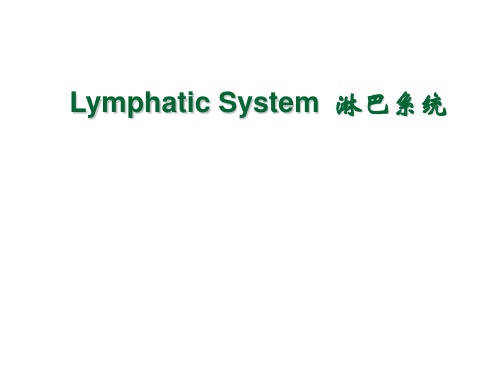
Cell
Tissue fluid
120ml/h
Lymphatic vessel
淋巴 lymph
Composition of the Lymphatic System
Lymphatic vessels 淋巴管 Lymphatic capillary 毛细淋巴管 Lymphatic vessels 淋巴管 Lymphatic trunks: 淋巴干(九条) Lymphatic ducts: 淋巴导管 thoracic duct 胸导管 right lymphatic duck 右淋巴导管 Lymphatic tissue 淋巴组织 Lymphatic organ 淋巴器官 Lymphatic nodes 淋巴结 Spleen 脾 thymus 胸腺 Tonsil 扁桃体
Prelaryngeal lymph nodes 喉前淋
巴结 Thyroid lymph nodes 甲状腺淋巴 结 Pretracheal lymph nodes 气管前淋 巴结 Paratracheal lymph nodes 气管旁 淋巴结
Lymph nodes of the neck
侧上深淋巴结 inferior deep lateral cervical ln.颈外 侧下深淋巴结 Efferent vessels
form the jugular trunk 颈干
Receive lymphatic vessels from head,
neck, tongue, larynx, cervical parts of esophagus and trachea, thyroid gland, upper parts of the thoracic wall and breast
淋巴系统 解剖PPT课件
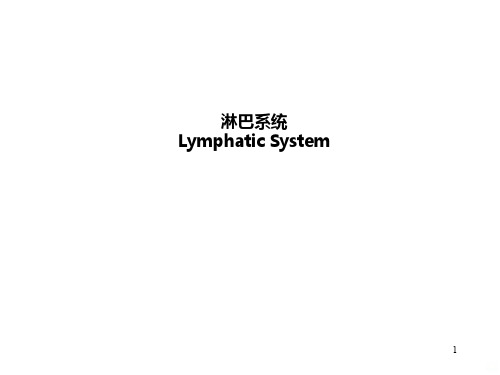
腋淋巴结Axillary lymph nodes :
位于腋窝内,沿血管排列 胸肌淋巴结Pectoral ln.
位于胸小肌下缘,胸外侧动、静 脉周围收纳胸、腹外侧壁和乳房外侧和 中央部的淋巴
注入中央淋巴结和尖淋巴结 外侧淋巴结Lateral ln.
沿腋静脉远侧段周围排列 收纳上肢大部分浅、深淋巴管 注入中央淋巴结、尖淋巴结和 锁骨上淋巴结 肩胛下淋巴结Subscapular ln. 沿肩胛下血管排列 收纳颈后部和背部的淋巴 注入中央淋巴结和尖淋巴结
左颈干注入胸导管 右颈干注入右淋巴导管 锁骨上淋巴结 斜角肌淋巴结 咽后淋巴结
17
18
二、上肢的淋巴管和淋巴结 深浅淋巴管分别伴行浅静脉和深血 管,注入腋淋巴结 肘淋巴结Cubital lymph node :
位于肱骨内上髁上方和肘窝深血 管周围
引流手及前臂尺半侧 注入腋淋巴结 锁骨下淋巴结Infraclavicular nodes : 位于锁骨下,三角胸肌间沟内, 沿头静脉排列 注入腋淋巴结或锁骨上淋巴结
位置:下颌下腺的附近和 下颌下腺实质内。
引流:面部和口腔器官的 淋巴。
13
(二)颈部的淋巴结
颈前淋巴结Anterior cervical ln.
颈前浅淋巴结
颈前深淋巴结
喉前淋巴结
甲状腺
淋巴结
气管前淋巴
结
气管旁淋巴结
颈外侧淋巴结Lateral cervical ln.
颈外侧浅淋巴结Superficial lateral
Cell
Tissue fluid
Lymphatic
capillary
Lymphatic duct
Lymphatic trunk
淋巴系统作用英文版
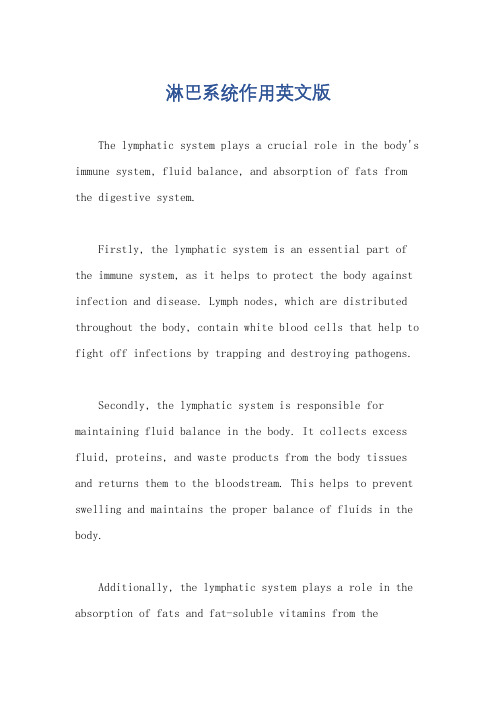
淋巴系统作用英文版The lymphatic system plays a crucial role in the body's immune system, fluid balance, and absorption of fats from the digestive system.Firstly, the lymphatic system is an essential part of the immune system, as it helps to protect the body against infection and disease. Lymph nodes, which are distributed throughout the body, contain white blood cells that help to fight off infections by trapping and destroying pathogens.Secondly, the lymphatic system is responsible for maintaining fluid balance in the body. It collects excess fluid, proteins, and waste products from the body tissues and returns them to the bloodstream. This helps to prevent swelling and maintains the proper balance of fluids in the body.Additionally, the lymphatic system plays a role in the absorption of fats and fat-soluble vitamins from thedigestive system. Lacteals, which are specialized lymphatic vessels in the small intestine, absorb dietary fats andfat-soluble vitamins and transport them to the bloodstream.In conclusion, the lymphatic system is essential for immune function, fluid balance, and the absorption of fats from the digestive system. Its role in these processes is crucial for maintaining overall health and well-being.。
解剖生理脉管04淋巴系统汇总

胸导管组成 ①乳糜池:位于第1腰椎
前面,由肠干及左、右腰干汇合而成。
②左支气管纵隔干。③左锁骨下干。 ④左颈干。 走行位置 下端起于梭形膨大的乳糜 池,上行穿膈的主动脉裂孔入胸腔, 经胸主动脉与奇静脉之间上升,在颈 根部呈弓形弯曲注入左静脉角。
收纳范围 下半身(腹盆部、 双下肢)和左侧上半身(左头 颈、左上肢、左胸部)。约占 全身的3/4。
巴管分为浅淋巴管和深淋巴管两类。
淋巴干
是由淋巴管汇集成的较大 的淋巴管道,收集一定区域的
淋巴。全身共有9条。包括腰
干、支气管纵隔干、锁骨下干、 颈干各2条和1条肠干
淋巴导管
胸导管、右淋巴导管分别注入左、
右静脉角
胸导管
是人体主要的淋巴导管,下端起 于棱形膨大的乳糜池,最后注入 左静脉角。通过 6 条淋巴干(左 腰干、右腰干、肠干、左支气管 纵隔干、左锁骨下干、左颈干) 收 集 约 占 全 身 的 3/4 的 淋 巴 。 (P228图11-3)
汇入 左静脉角。
右淋巴导管
组成 右淋巴导管为一短干(长 约1-1.5厘米),由右颈干、右锁 骨下干和右支气管纵隔干汇合而成。 收纳范围 右侧上半身(右头颈、 右上肢、右胸部),约占全身的 1/4。 注入 右静脉角。
二、淋巴器官
包括淋巴结、胸腺、脾和扁桃体。
淋巴结
位置:多成群存在于较隐蔽的部位,如肢体屈侧、 大血管周围和内脏器官的门附近等。 形态:圆形或椭圆形小体。它一侧凸隆,另一侧凹 陷称为门。输入淋巴管从凸侧进入 ,输入淋巴 管从门发出,上一个淋巴结的输出管就是下一 个淋巴结的输入管。一条淋巴结链的最后一个 淋巴结的输出管便注入相应的淋巴干。按位置 不同可分为浅、深淋巴结 功能:滤过淋巴、产生淋巴细胞和进行免疫应答。
淋巴系统

淋 巴 结 的 微 细 结 构
脾脏
全身淋巴的流注关系
淋巴系统常见疾病:
严重失眠多梦、头昏、头痛、疲劳 嗜睡、心情沮丧、心率不整、低沉、 精神特差、忧郁严重、嫉妒心强、 神经官能症、歇斯底里、高血压 、 脑积水、癫痫、早老性痴呆、帕金 森综合症、脑萎缩、儿童多动症等
最好的医生 就是自己
胸 导 管 和 右 淋 巴 导 管
胸导管
1.胸导管是最大的淋巴管道, 由左、右腰干和肠干在第1腰 椎前方汇合而成,其起始处常 较膨大,称乳糜池.胸导管起 始后,向上经膈的主动脉裂孔 入胸腔,在食管的后方,沿脊 柱的前面上行,到颈根部呈弓 形弯行向左,注入左静脉角. 胸导管的末端接受左颈干、 左锁骨下干和左支气管纵隔 干.胸导管通过上述6条淋巴 干汇集左半头颈、左上肢、 左半胸、腹、盆部和两下肢 的淋巴。 2.右淋巴导管很短小,由右 颈干、右锁骨下干和右支气 管纵隔干汇合而成,注入右 静脉角。右淋巴导管汇集右 半头颈、右上肢和右半胸的 淋巴
淋巴干:全身各部浅、深淋巴管,经过一系 列淋巴结,各部最后一群淋巴结的输出淋巴管汇 集成相应的淋巴干(trunci lymphatici)。
全身共汇集成9条淋巴干: 头颈部淋巴管汇合成左、右颈干。 上肢及部分胸壁的淋巴管汇合成左、右锁骨下干。 胸腔器官及部分胸腹壁的淋巴管汇合成左、右支气管 纵隔干。 腹腔不成对器官的淋巴管汇合成1条肠干。 下肢、盆部和腹腔成对器官及部分腹壁的淋巴管汇合 成左、右腰干。 全身9条淋巴干最后合成2条淋巴导管,即胸导管和右 淋巴导管,分别注入左、右静脉角。
巴淋 干巴 和管 淋道 巴包 导括 管毛 。细 淋 巴 管 、 淋 巴 管 、 淋
毛细淋巴管
淋 巴 管
由毛细淋巴管汇合而成.其结构与静脉相似,也有丰富的瓣 膜.淋巴管以深筋膜为界,分浅、深两种,浅淋巴管位于浅 筋膜内,多与浅静脉伴行;深淋巴管与深部的血管伴行.淋 巴管在向心的行程中,一般都经过一个或多个淋巴结。
- 1、下载文档前请自行甄别文档内容的完整性,平台不提供额外的编辑、内容补充、找答案等附加服务。
- 2、"仅部分预览"的文档,不可在线预览部分如存在完整性等问题,可反馈申请退款(可完整预览的文档不适用该条件!)。
- 3、如文档侵犯您的权益,请联系客服反馈,我们会尽快为您处理(人工客服工作时间:9:00-18:30)。
组成 功能
淋巴管道
毛细淋巴管
淋巴管 淋巴干
淋巴导管
淋巴结 淋巴器官 脾
胸腺
淋巴组织:分布于消化道和呼吸道 的粘膜内
协助体液回流
免疫功能
1
一、淋巴系统的组成和结构特点
(一)淋巴管道 1.毛细淋巴管 lymphatic capillary 2. 淋巴管 lymphatic vessel 3. 淋巴干 lymphatic trunk 4. 淋巴导管 lymphatic duct
2
(一)淋巴管道 1. 毛细淋巴管 2. 淋巴管
可分为浅淋巴管和深淋巴管两种,管壁内有瓣 膜,防止淋巴逆流。
3
3.淋巴干
左、右颈干
头颈部
左、右锁骨下干 上肢、部分胸壁
共
9 左、右支气管纵隔干 胸腔脏器、部
条 肠干
分胸腹壁 腹腔不成对脏器
左、右腰干
4.淋巴导管
下肢、盆部、腹腔成对器 官、部分腹壁
胸导管 右淋巴导管
8
2. 脾spleen
位置:位于左季肋区,第9~11肋的深面 前端 后端
形态 上缘 下缘 脏面 膈面
功能:造血、滤血、清除衰老血细胞、参与免
疫反应
脾门
第9肋
脾 切 迹
脾切迹是触诊脾的标志
9
3. 胸腺 位置:胸骨柄后方,心包上方,大血
管的前面。
形态: 分成左右两叶,每叶呈
扁条状,新生儿和幼儿 的胸腺较大,性成熟时 最大,成人胸腺被结缔 组织代替。
11
胸导管引流下肢、盆部、腹
部、左上肢、左胸部和左头 颈部的淋巴,即全身3/4部位 的淋巴
Right lymphatic duct
Thoracic duct
Cysterna Chyli
二、右淋巴导管
长1~1.5cm 由右颈干、右锁骨下 干、右支气管纵隔干汇 合而成,注入右静脉角
右淋巴导管引流右上肢 右胸部和右头颈部的淋 巴,即全身1/4部位淋 巴
腋淋巴结
三、胸部的淋巴管和淋巴结 胸壁淋巴结
胸腔脏器淋巴结
纵隔前淋巴结
气管、支气管 、肺的淋巴结
腋
纵
淋
隔
巴
后
结
淋
巴
结
16
(三)腋淋巴结
axillary lymph node
位于腋窝疏松结缔组织内, 沿
血管排列,按位置分为五群
1. 胸肌淋巴结 2. 外侧淋巴结 3. 肩胛下淋巴结 4. 中央淋巴结 5. 尖淋巴结
4
5
(二)淋巴器官 Lymph Organs
Lymph nodes Tonsils Thymus Spleen
6
1. 淋巴结
输出淋巴管
输入淋巴管
7
Distribution of LNs
Cervical lymph nodes - drain head and neck Axillary lymph nodes - drain arms and breasts Popliteal lymph nodes - drain legs Inguinal lymph nodes - drain lower limb Thoracic lymph nodes - drain thoracic viscera Abdominal lymph nodes - drain pelvic region Intestinal and mesenteric lymph nodes - drain abdominal viscera
纵隔前淋巴结
气管、支气管 、肺的淋巴结
纵 隔 后 淋 巴 结
20
四、下肢的淋巴管和淋巴结 腘淋巴结 腹股沟浅淋巴结 腹股沟深淋巴结
21
Hale Waihona Puke 1718三、胸部淋巴管和淋巴结 (一)胸壁淋巴结
胸后壁和胸前壁的大部分浅淋巴管注 入腋淋巴结
1. 胸骨旁淋巴结 2. 肋间淋巴结 3. 膈上淋巴结
19
(二)胸腔器官淋巴结
1. 纵隔前淋巴结 2. 纵隔后淋巴结 3. 气管、支气管和肺的淋
巴结 ①肺淋巴结 ②支气管肺淋巴结 ③气管支气管淋巴结 ④气管旁淋巴结
13
第三节 人体各部的淋巴结和淋巴引流范围
一、头颈部淋巴管和淋巴结
(一)头部的淋巴结
多位于头、颈部 交界处,引流头 面部淋巴,输出 淋巴管注入颈外 侧上深淋巴结
腮腺淋巴结 乳突淋巴结
枕淋巴结
颏下淋 巴结
下颌下淋巴结
14
(二)颈部的淋巴结
颈
外
颈
侧
外
深
侧
淋
浅
巴
淋
结
巴
颈结
前
淋
巴
结
锁骨上淋巴结
15
二、上肢的淋巴管和淋巴结 肘淋巴结 锁骨下淋巴结
10
第二节 淋巴导管
一、胸导管
thoracic duct 平第12胸椎下缘高度起自乳糜 池位于第1腰椎前方由左、右腰 干和肠干汇合成的囊状膨大
胸导管经主动脉裂孔进入胸腔 沿脊柱右前方上行至第5胸椎 向左侧斜行至脊柱左前方上行 经胸廓上口至颈部注入左静脉 角
并接受左颈干、左锁骨下干 和左支气管纵隔干
